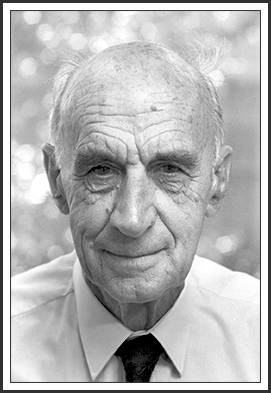Krupičkaite: A new copper arsenate mineral
11 February 2022

A new copper arsenate mineral, Krupičkaite, has recently been named in honor of the late Jiří (George) Krupička, a former professor in our department (PDF: American Mineralogist, Volume 107, pages 318–320, 2022). It’s a great honor for a geologist to have a mineral named after him but this recognition by the geological community is only a very small part of the remarkable story of an amazing man.
George Krupička was born in 1913 in Czechoslovakia (now the Czech Republic). He initially studied and then later taught humanities subjects but, after WWII, earned a doctorate in geology from Charles University in Prague. Even though he was now a professional geologist and a researcher at the University, George never lost his interest in the humanities. Soon after completing his PhD, he wrote a manuscript (in English) on the dangers of atomic energy and the nuclear arms race. For his efforts, the Czechoslovak government, by now under Soviet domination, sentenced him to 16 years of hard labor, ironically in a uranium mine supplying the Soviet nuclear program. George was popular with his fellow prisoners, organizing discussion groups and teaching English language classes. Unfortunately, these activities were not well received by the prison authorities. George was sentenced to 5 months of ‘solitary confinement’, which turned out to be 5 months in a small cell with a convicted murderer with severe mental problems. He described this as the worst time of his life and noted that being released from solitary and sent back to hard labor in the mines with the other inmates seemed like paradise by comparison.
George was released from prison and reunited with his family in 1960, having served 10 years of his 16-year sentence. After spending 3 years as a laborer, George returned to his geological work at the university. Undeterred by his time in prison, George also returned to his role as a dissident and was an organizer in a political liberalization movement taking place in Czechoslovakia during the late 1960’s known as the ‘Prague Spring’. As it turned out, an international geological congress (23rd IGC) was to be held in Prague in August 1968, with ~3000 delegates from 91 countries attending. George was a leader of one of the pre-meeting field trips associated with the conference, which by chance was attended by U of A faculty member Professor Ron Burwash. On the first night of the formal conference, Soviet tanks rolled into the city to crush the Prague Spring movement. George, very much in danger of being re-imprisoned for his political views, was forced to flee the country.
Now 55 years old, George found himself stateless, jobless and a political refugee. In significant part because of his earlier meeting with Professor Burwash on the IGC field trip, George was able to land a position as a contract lecturer in the Department of Geology at the U of A. This temporary position eventually turned into a tenure-track position and, over the subsequent decade, George rose up through the academic ranks, eventually being promoted to full professor. His research interests were in metamorphic rocks and the Canadian Shield. Despite his advanced age, George was very active in fieldwork, joining Geological Survey of Canada mapping parties in the high Arctic, particularly Devon and Ellesmere Islands, as well as other parts of the Shield.
At that time, all U of A faculty members were required to retire at age 65. As such, George officially retired and became professor emeritus in 1978 but continued to teach courses in the geology program for another decade as a sessional instructor. Now 75 years old, one would think that George would have settled in for a quiet ‘full’ retirement. Nothing could be further from the truth. From 1988 to 2008, he wrote and published 7 books in his native Czech language. One of those books, Renaissance of Reason, was published in 1994 and picked by the Czech president at the time, Vaclav Havel, as the book of the year. He was also the recipient of numerous awards in the Czech Republic, both for his work in science as well as his work as a writer on philosophical and socio-political topics. George passed away in 2014, a few weeks before his 101st birthday.
It is very fitting that a new mineral, Krupičkaite, has been named after this remarkable man and also fitting that the type specimen of this mineral was found in a uranium mine in the Czech Republic.
Summary by Tom Chacko; February 11, 2022